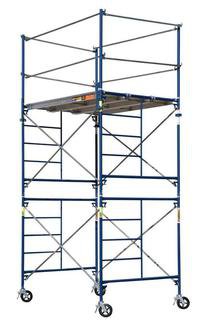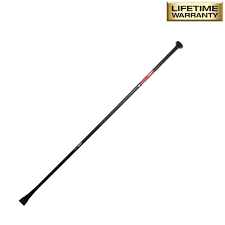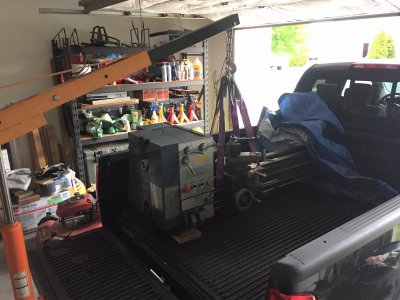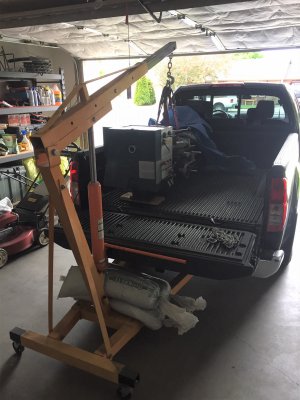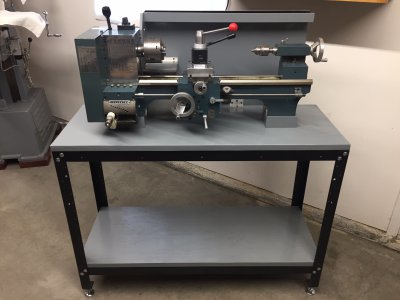- Joined
- Oct 17, 2018
- Messages
- 922
I'm going to be making a new workbench for my lathe and mill (the wife needs more room in the garage and I like to keep her happy), so I need to safely move my machine to a better spot. I have an engine lift and two straps. I've lifted the lathe before, but it tipped back and sideways because of the weight distribution. Scared the hell out of me! It was not cleaned up or fully assembled then, either. I'm concerned I will break something this time. I'm not sure a load balancer would work, though. However, I haven't tried it. It seems like I would need something that levels the load in two directions: left/right and front/back.
What is the safest way to move this so it doesn't tip? I only need to move the lathe about 20 feet over a level and smooth garage floor. It weighs about 350 lbs.
Any pictures of the strapping method would be great.
I found this from wa5cab.
If you have to do it by yourself, you should make a spreader bar from say a 4" by 1/2" flat bar or the equivalent in a "T" or two pieces of steel angle about 4 feet long. Rig up two choker straps or use one long one. Put the chokers around the headstock and the tailstock to keep the top-heavy lathe from turning over. Attach them to the ends of the spreader bar. With the carriage at the tailstock end of the bed, by test lifts, find the balance point for attaching the spreader to the hoist. If you need to move the lathe several feet, lift it enough to set it down on the hoist's legs until you have it in the final lifting position.
Is this the spreader bar? Making a simple one is an option as well, as long as there is no welding.
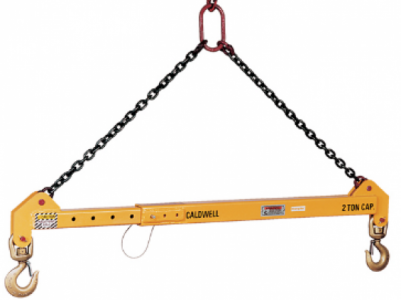
This would work, wouldn't it:
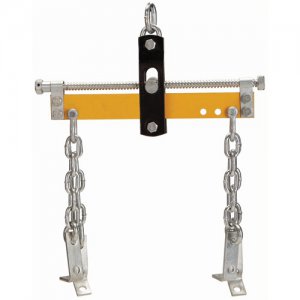
I think I can get the lathe balanced "left/right", but the motor and bracket stuff on the back still unbalances it from front to back; how do I solve this? I took the motor off and all the mounting hardware as well and it still tipped. Maybe get a third strap and attach that to lift the back? I'd have a triangle of straps instead of just two.
What is the safest way to move this so it doesn't tip? I only need to move the lathe about 20 feet over a level and smooth garage floor. It weighs about 350 lbs.
Any pictures of the strapping method would be great.
I found this from wa5cab.
If you have to do it by yourself, you should make a spreader bar from say a 4" by 1/2" flat bar or the equivalent in a "T" or two pieces of steel angle about 4 feet long. Rig up two choker straps or use one long one. Put the chokers around the headstock and the tailstock to keep the top-heavy lathe from turning over. Attach them to the ends of the spreader bar. With the carriage at the tailstock end of the bed, by test lifts, find the balance point for attaching the spreader to the hoist. If you need to move the lathe several feet, lift it enough to set it down on the hoist's legs until you have it in the final lifting position.
Is this the spreader bar? Making a simple one is an option as well, as long as there is no welding.

This would work, wouldn't it:

I think I can get the lathe balanced "left/right", but the motor and bracket stuff on the back still unbalances it from front to back; how do I solve this? I took the motor off and all the mounting hardware as well and it still tipped. Maybe get a third strap and attach that to lift the back? I'd have a triangle of straps instead of just two.


 I had to have a brew party years back to get my buddies to help return my first 17" to an upright position . Slow and steady these days .
I had to have a brew party years back to get my buddies to help return my first 17" to an upright position . Slow and steady these days .